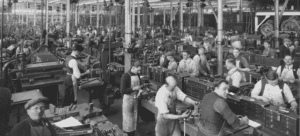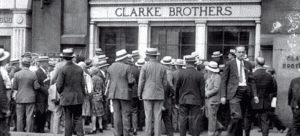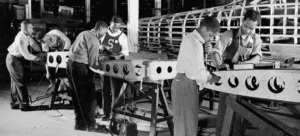How Did Easy Consumer Credit Help the U.s. Economy During the Early 1920s?
Pressed for time? Here's a summary.
From the 1920s through 1950s, our modern consumer credit system took shape. These decades saw the invention of installment credit, long-term mortgages, and revolving credit. And the basis of our modern consumer credit landscape was formed. From retail to homeownership, no facet of American life was unaffected by the changes to the U.S. economy over these three decades.
Introduction: Pre-industrialization, Grocers, Loan Sharks
Love it or hate it, consumer credit is the backbone of modern living. From retail shopping to education and housing, no corner of our existence is untouched by it.
Things weren't always this way. One hundred years ago, consumer credit as we know it didn't exist. Local grocers offered credit to frequent customers, but credit cards haven't been invented. Personal loans were reserved for wealthy businessmen only. Everyone else had to borrow from family and neighbors…or loan sharks.
Loan sharks were for the truly desperate, and many were.
Let's say it is 1901 and you work in a steel factory. If your hours get reduced, it means you'll need to find $25 to cover the month's rent and bills. Most likely, you'll turn to a loan shark for the money. The interest rate on the loan will be anywhere between 60% and 480%. And because you don't own property, your furniture or other assets will be used as collateral.
Many accepted these harsh terms simply because there was no other way to get a loan. So what happened? How did we get from that to today's robust culture of consumer credit and personal lending?
In part one of this two-part series, we explore the events that formed the foundations of modern consumer credit and helped it go mainstream.

The Roaring 20s: Mass Production, Cars, and Installment Credit
The year is 1915. Cars have been on the market for eight years and you're thinking about buying one. First question to ask yourself: Am I rich? Running at an average of $2,000 (roughly $53,300 today) , cars could only be bought in cash.
Clearly unaffordable for most Americans, cars were a luxury item for the wealthy. Even Henry Ford's mass manufactured Model-T ran at an "affordable" $850 (roughly $20,000 today) .
Installment Credit is Born
In 1919, you learn auto-makers are offering some ways to help you buy a car:
Option 1: Ford's "Weekly Payment Plan". Ford will set your selected car aside until you've paid for it in full:
- Step 1: Make the down payment.
- Step 2: Make $5 or $10 weekly payments until car's been paid for in full.
- Step 3: Take your car home from the layaway.
Option 2: General Motor Acceptance Corporation (GMAC)'s installment credit plan. GMAC will loan you the money to buy a car:
- Step 1: Make the 35% down payment.
- Step 2: Take your car home.
- Step 3: Repay the remainder of the loan over the course of a year in installments.
Which option would you choose?
Most Americans chose GMAC's installment credit plan, and General Motors (GM) became the leading car maker. GM's success birthed car finance companies. These companies will lend money directly to you so you can buy cars on installment credit.
So many car finance companies popped up, that to survive, many expanded their financing to durable goods. For example, radios, fridges, and furniture with installment credit. Of course, if buyers defaulted, what they bought would be repossessed.
As the installment credit scheme took off, so did personal lending firms. These firms followed usury laws (limited interest rates) and operated legally. Now if people had an emergency or needed money, they no longer needed to go to loan sharks.
Installment credits and legal personal loan firms made it safer and cheaper for Americans to borrow. These companies permanently changed the country's relationship to credit and lending. Credit became more socially acceptable. Finance became an industry. Businesses everywhere started to see the value of consumer credit.
Of course, not everyone had equal access to these changes. If you were poor, you'd still be at the mercy of loan sharks. Without credit, you wouldn't have been able to enjoy the improving standards of living that installment finance offered.

The Great Depression: The 1930s, Home Mortgages, and Banks
In 1933, the U.S. housing market was collapsing. To avoid complete disaster, the Government created the Federal Housing Administration (FHA) as part of its New Deal. The FHA had one goal: to create jobs and stimulate demand for building materials.
FHA created two programs: Title I Loans and Title II Mortgages. The government decided not to offer homeowners direct assistance. Instead, the government would insure bank-issued home loans. If a homeowner defaulted, the bank would always get the principal back.
Title I Loans and Title II Mortgages
In 1934, many homes still lacked electricity. If you owned such a home, you could apply for a Title I Loan to modernize it.
- Step 1: Head to your local bank and apply for a Title I Loan.
- Step 2: Select a repayment that either lasts one month or up to five years. (The interest on your loan would be less than any installment credit contract for a durable good.)
- Step 3: Now that your home has been wired with electricity, you can actually buy that radio, air conditioner, and automatic garage door opener you've been eyeing.
If you don't own a home, you can apply for a Title II Mortgage to buy a FHA insured house.
- Step 1: Head to your local bank and apply for a Title II Mortgage.
- Step 2: Mortgages would be up to 15 years. You may be shocked. Prior to the 1930s, mortgages lasted an average of three to five years. Houses used to be considered short-term debts, but no longer. They are now good, long-term investments.
- Step 3: Enjoy your home and new neighborhood, most likely in the suburbs.
Consequences of FHA programs
The consequences of the two programs were immense. Title I Loans meant Americans could cheaply and easily improve living conditions. Title II Mortgages introduced the country to suburban living.
Title II Mortgages inadvertently created the suburbs. The FHA created an Underwriting Manual to help banks identify properties that met its "good" housing rating. If you bought a well-rated home, it was likely you'd qualify for the cheap and government-insured mortgage.
Suburban homes easily rated well. They could be built to meet the new housing codes. They were also built to look the same because that was believed to produce stable prices. For these reasons, banks started to see suburban homes as having greater value than those in urban areas.
The success of the two FHA programs gave banks the confidence to expand into the personal loans business. If you took out a personal loan with the bank, your address and stable future salary would be used as collateral instead of assets.
Banks entering the consumer lending space gave rise to credit reports and 24/7 banking. Ads reminded consumers that taking out a loan means establishing credit. Once credit's been established, it's easier to borrow again. Sounds familiar?
Consumer lending and suburban mortgages clearly favored those who were middle-class and salaried. If you were poor and working-class white, African American, or an unmarried woman, you wouldn't have been able to access these benefits of credit.

Wartime Regulations: The 1940s and 1950s, and Revolving Credit
During the Second World War, the government tried to contain inflation by regulating installment credit. With less credit for consumers, sales fell hard. This motivated retailers to create hybrid credit plans that weren't regulated. This was the first step towards revolving credit.
Hybrid credit plans went a little something like this:
Suppose you want to buy some new clothes. Instead of paying for it in installments at the end of each month, the store clerk would help you open a charge account. Your purchase would be recorded in the books and you'd repay over time. You might ask: what if I paid for my purchase slowly or very little at a time? Well, that'll be up to you because you're being charged interest on the balance. Sounds familiar?
Birth of Revolving Credit
New technologies helped retailers manage these hybrid credit accounts. The Charga-Plate and Addressograph made it easy to identify customers and their address. Bookkeeping duties were simplified and it became easier to freeze accounts, which helped retailers comply with installment credit regulations. Added together, revolving credit began to formalize.
The use of revolving credit continued after the war , even after installment credit regulations were removed. The government tried to regulate revolving credit during the Korean War. However, that only made it more popular. By the end of the Korean War in 1953, revolving credit plans and inventions like the Charga-Plate made consumer business a central aspect of American finance.
Revolving credit completely altered the shopping experience. Poorer customers became indistinguishable from wealthy customers. Once reserved for the wealthy, now anyone with a revolving credit account can say to a store clerk, "Charge it!"
Recap and Conclusion
From the 1920s to the early 1950s, we can see our modern-day consumer credit landscape take shape. Installment credit was used for car purchases and large household goods, such as refrigerators and radios. Everything else was paid for using revolving credit. Banks' decision to offer home loans and personal loans supercharged the formation of modern credit bureaus and 24/7 banking.
Within a few decades, the American economy completely transformed to center consumer life. What do the next few decades hold for consumer credit? Find out in part 2 of this series: A Brief History of Consumer Credit – Part 2: Consumer Credit Becomes a Right.
References
Desjardins, Jeff. "The History of Consumer Credit in One Giant Infographic." Visual Capitalist. August 29, 2017. https://www.visualcapitalist.com/history-consumer-credit-one-infographic/
"The History of Credit." Rocket HQ. June 4, 2021. https://www.rockethq.com/learn/credit/the-history-of-credit
Hyman, Louis. Debtor Nation. Princeton: Princeton University Press, 2011.
Olegario, Rowena. "History of Credit in America." American History. Oxford Research Encyclopedia, May 23, 2019. https://oxfordre.com/americanhistory/view/10.1093/acrefore/9780199329175.001.0001/acrefore-9780199329175-e-625
"Report to the Congress on Practices of the Consumer Credit Industry in Soliciting and Extending Credit and their Effects on Consumer Debt and Insolvency." Board of Governors of the Federal Reserve System. June 2006. https://www.federalreserve.gov/boarddocs/rptcongress/bankruptcy/bankruptcybillstudy200606.pdf
Smith, Stephen. "The American Dream and Consumer Credit." A Better Life. American Public Media. Accessed July 8, 2021. https://americanradioworks.publicradio.org/features/americandream/b1.html
Williams, Geoff. "A Glimpse at Your Expenses 100 Years Ago." U.S. News. & World Report. January 2, 2015. https://money.usnews.com/money/personal-finance/articles/2015/01/02/a-glimpse-at-your-expenses-100-years-ago
Source: https://esusurent.com/blog/a-brief-history-of-u-s-consumer-credit-part-1-making-consumer-credit-mainstream/
Post a Comment for "How Did Easy Consumer Credit Help the U.s. Economy During the Early 1920s?"